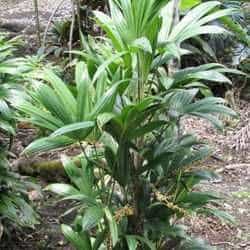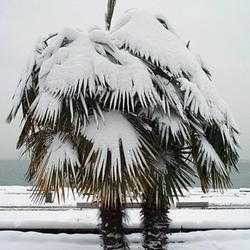Most of the environmental extremes that one might include in terms of hardiness are usually described as ‘tolerances'. For example, drought tolerance, heat tolerance, wind tolerance, salt tolerance, poor soil quality tolerance, humidity tolerance and cool tolerance. For me, the terms hardiness and tolerance are nearly synonymous as a palm's ability or failure to survive such extremes is indeed a form of hardiness.
Cool hardiness is probably one of the more difficult concepts to grasp but one of the most important in terms of cultivation of palms. When one is learning about palms, one quickly finds that most palms have a USDA rating mentioned above. This means little to those who live outside the US, but I have to believe there are equivalent ratings in other continents in marginal climates as well. Cold hardy palms (see previous articles on the subject in Davesgarden) are usually considered those that can survive outside the tropics, usually in zones 10a or below. The problem with this simplified climate rating system, other than its uselessness in other marginal climates around the world is its inability to take into account microclimatic variations, other environmental extremes mentioned above, and most importantly, does not take into account a palms ‘cool hardiness'. Cool hardiness and cold hardiness are not the same thing. Some palms are very cool hardy, but may not be that cold hardy. And vice versa. Cool hardiness is the ability to tolerate a cool climate (winter usually) for an extended period of time. For example, a Coconut palm is not a very cold hardy palm, but is even less a cool hardy palm. Coconuts easily survive zones 9b-10a in a warm, humid climate such as those found in Florida (though will often eventually die during a super freeze that those marginal zones in Florida experience now and then)... but seeing mature coconuts in such climates is not a rare occurrence. However, in a cool climate, such as the Mediterranean climate of coastal California, such palms cannot even survive zones 10b, except in the most ideal of microclimates. Why not? Coconuts may survive extreme lows, and may be damaged by them, but if warmed up quickly, they will recover. But in California, even without the severe lows that damage Coconuts in Florida, there is the prolonged cool which devastates these normally tropical palms. Coconuts need warmth to survive and without it, perish, even if the extremes they experience are not severe.

Thought of as a tropical palm, Coconuts can tolerate frosts in warm humid climates and rebound well... but do NOT do well in cool climates
There are several good examples of cold hardy but not cool hardy palms: some include Borassus, many Copernicias, Coryphas, Eleias, Latanias, some Oranias etc. These palms can often survive freezing temps in a warm humid climate with minimal damage and quickly recover, growing into healthy, mature palms (often usually in a fraction of the time they could in a cooler climate should they manage to survive one). However, try to grow any of these in California even in zones that never see a freeze and one will be in for a struggle in all but the best 10b climates (some manage to grow Latanias in 10a, but they rarely flourish). Most will simply not grow in California.



Borassus aethiopium in central Florida survives freezes down to 22F; Borassus flabilifer is a tad touchier, but can still be grown in central Florida; Copernicia hospita is another good palm for Florida but nearly hopeless in most of the California cool climates



Copernicia macroglossa, though can survive some unique California microclimates is NOT a good cool climate palm... neither is Corypha utan (second two photos) which surives central Florida frosts easily


Elaeis (Oil palms) can survive a good deal of cold weather as long as it warms up quickly... same with Latanias. But neither thrive in a cool climate, though Latanias are one of the hardier non-cool-climate-palms surviving and even doing well in some of the prime microclimates in California
Examples of cool hardy palms include Rhopalostylis, many Dypsis, most New Caledonian palms, some Chamaedoreas, Parajubaeas and Jubaea, Ceroxylons and, to some degree, Archontophoenix. These palms rarely suffer from the prolonged cool, wet winters typically experienced in California that usually kill off the above palms that are not cool hardy... yet the absolute minimum these cold hardy palms can survive may be above that of the non-cool hardy palms listed above. Some of these cool hardy palms cannot even be grown in the Florida climates due to the constant high heat and humidity which some of these species detest.



Basselinia gracilis and Cyphophoenix elegans are two New Caledonian palms that excell in a cooler Mediterrean climate, though do even better in a tropical one... but Washingtonia filifera is a good example of a cool hardy (and heat hardy) palm that does NOT do well in a tropical or humid climate



Archontophoenix do well in Florida, but also thrive in California cool climates, often taking a lot more cold there than in Florida; Rhopalostylis are tough grows in Florida, but do great in cool climates; Parajubaeas are nearly impossible in Florida but make great cool climate palms
So when one is learning about palms and deciding which species can be grown in one's yard, one has to do more than just look at the palm's cold hardy USDA rating, but research the palm's cool hardiness as well.
Perhaps just as important as cool tolerance is a palm's heat tolerance. Some palms simply cannot tolerate hot climates, particularly arid, hot climates. Many palms originate from higher elevations and cannot adapt to an arid and/or constantly hot climate. On the other hand, some palms grow better and better the hotter it is. Some excel in hot, arid climates and most palms excel in hot humid climates.



Bismarckias and their related Hyphaenes are two genera that are exceptionally heat tolerant palms
Examples of palms that are NOT tolerant of arid heat include most crownshafted palms. Hot, inland desert climates, such as those experienced in Arizona or inland California, can have humiditys below 10% most of the year, and highs well over 100F, often day after day, with lows barely dipping into the 80s or even the 90s at night in summers. Most palms that have a crownshaft cannot tolerate this sort of extreme climate, though there are a few exceptions (Wodyetia and Roystonea are two such exceptions, though each have their heat limits as well). Most fan palms are fairly heat tolerant, but some Trachycarpus might be included as fan palms that cannot tolerate excessive heat. So for a crownshafted or Trachycarpus palm that might have a USDA rating of let's say 8b for example, one might make the assumption one could grow such a palm in Palm Desert,California, a 10a climate. However, the summer heat of such a location is prohibitive for many species of palms with ratings of 8b or higher. Again, there is far more to palm hardiness than the USDA rating it has.



Archontophoenix alexandrae, Chamaedorea fragrans and Dypsis leptocheilos are just 3 of many hundreds of species of crownshafted palms (most Chamaedoreas don't have true crownshafts, but few are heat hardy anyway) that are not dry heat tolerant (aka arid-hardy)



Examples of thee crownshafted palms that are relatively heat tolerant: Roystonea, Wodyetia and Pseudophoenix... these are the exceptions, however
In most areas of the world where such heat extremes are encountered, and where palms are grown, the winters tend to get relatively cold. This is certainly true for Arizona and California. These wide temperature extremes mean that palms that can survive such climates usually need to be fairly cold tolerant as well as heat tolerant (few palms exist that are tolerant of high, arid heat but not at least somewhat cold tolerant). Such palms include Bismarckia, Chamaerops, some Copernicias, many Syagrus, Hyphaenes, Dypsis decaryi, most Sabals, Livistonas, Braheas, Nannarhops, Butias, Phoenix, Washingtonias etc. Some species of palms grown in California can only be grown successfully in the desert, though there are few that fit this description. Some Copernicias grow well in these climates that struggle elsewhere. Livistona inermis and Medemia argun are nearly impossible to grow anywhere in California but in the desert areas. Pseudophoenix can be grown in some coastal climates, but excels in inland California and Arizona. These last few palms listed here that grow best in California where it is hot and arid, perform even better in Florida where it is muggy and humid. Heat is the key to these plants' success, and aridity is just a tolerance they also happen to have.



Livistona victoriae, Nannorrhops and most Braheas (Brahea edulis in photo) are quite heat tolerant



Livistona inermis is seemingly a super hardy palm surviving in the outback of Australia with minimal water and tremendous heat... yet in California it is nearly impossible to grow (second photo is of one that is growing in Palm Desert and doing well, but it is easily an exception). Medemia argun survives in the north African desert in some of the most inhospitable climates known... yet also nearly impossible to grow in a cool but frost-free climate... needs a lot of heat!
Humidity tolerance is a term rarely used when describing palms as probably 98% of the world's palms are from humid climates. But some palms have an exceptionally low humidity tolerance, and this is another factor one may need to consider when trying to decide if a palm one would want to grow may survive one's environment. Jubaeas, Washingtonia filifera and most Braheas seem to have a relatively low tolerance for humid climates. If one adds heat to the equation, one can include Parajubaeas as well. One just need visit Hawaii and discover what palms one does NOT see growing there, and then one can add those to this list of palms that don't like warm, humid climates. However, as one goes up in elevation in Hawaii, some of the palms one struggles with near the coast can be grown more easily in such climates (Ceroxylons, Rhopalostylis and Lepidorrhachis quickly come to mind)... so these palms do not mind the humidity as much as the combination of warmth and humidity. Yet none of these peculiarities would begin to be gleaned from these palm's cold hardiness ratings.



Jubaea growing easily and beautifully in a dry, cool climate (southern California) but struggling mightily in this warmer but wetter Florida climate (second photo)... this palm has since died; Parajubaeas also seem particularly intolerant of humid climates... though some still manage to have them 'exist' in some parts of Hawaii



Ceroxylon ventricosum, Lepidorrhachis and Rhopalostylis baueri all struggle in a climate like coastal Hawaii... but seem to do well in the humid highlands of Hawaii where it is much cooler
Tolerances to salt, poor draining soil, wind etc. are can be researched as well (look in books such as Cultivated Palms of the World by Riffle and Craft, or Betrocks guide to cold hardy palms). Just know that when reading such texts that they are written by Florida growers and do not take into account the cool hardiness parameters mentioned above. There are NO books that cover this palm hardiness topic well, YET. But the information is out there- you just have to look in more places than one or two books. As long as one remembers that there is more to a palm's hardiness than being able to deal with cold extremes, and one will be less disappointed by one's personal palm growing experiences.

















